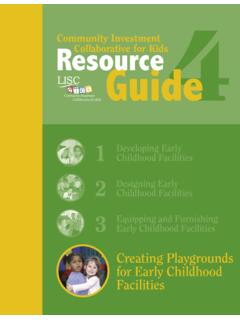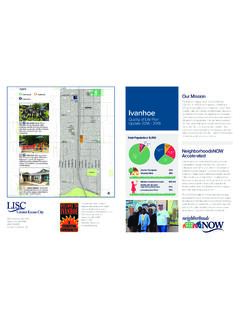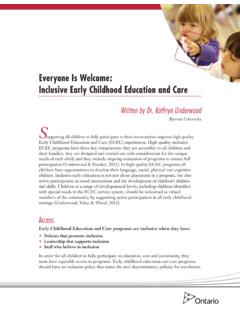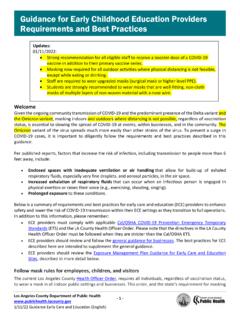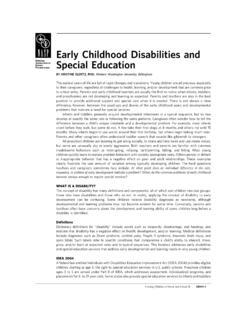Transcription of Designing Early Childhood Facilities
1 2 Designing Early Childhood Facilities Developing Early Childhood Facilities Equipping and FurnishingEarly Childhood FacilitiesCreating Playgrounds forEarly Childhood FacilitiesGuide Resource Community Investment Collaborative for Kids2 Guide Resource Community Investment Collaborative for KidsPublished by the Local Initiatives Support Corporation/Community Investment Collaborative for KidsContributing authors: Dogan W. Arthur, Cindy Larson, Amy Gillman and Carl SussmanAugust 2006 The authors and publisher are solely responsible for the accuracy of the statements and interpretations contained in this resource guide.
2 Contents Int roduction 1 Working with an Architect 1 The 5 Phases of the Design Process 2 Defining Your Space Needs 3 General Design Principles 10A Walk Through The Center 15 Exterior Building Entry 16 Interior Entry and Reception 17 Classroom Spaces 20 Gross Motor Rooms/ Multi-Purpose Spaces 28 Program Support Spaces 30 Lighting 35 Lighting Table 39 Exter ior Site Requirements 42 Security 44 Special Considerations for Urban Sites 46 Mate rials, Systems and Accessibility 48 Exterior Materials 48 Interior Materials 49 Climate Control and Building Systems 51 Accessibility 53 Facility Design Resource Materials 54 Publications 54 Web Links 54 Appendix 55 Sample Space Program CONTENTSit.
3 The design of a center can either promote or discourage contact between child and caregiver. It can create a pleasant work environment that eases the task of caregiving and makes caregivers want to stay on, or it can add to staff burdens, burnout, and turnover. Quoted from Anita Olds, Child care Design GuideiiIntroductionWhether you are constructing a brand new child care center or renovating your existing site it can be an exciting and challenging experience. A well-planned physical environment will support the implementation of a high quality program for young children in many ways; therefore, it is critical that you spend ample time, devote sufficient resources and give careful thought to the design of your new space.
4 This guide will help you better understand and navigate the many considerations that are part of creating a great environment for young guidelines presented here apply to all types of child care (center-based, family child care , back-up, drop-in, etc.) but have been developed primarily for child care centers serving infants through preschoolers. The concepts described reflect best practices in the Early care and education field and are intended to encourage you to think more about the vital connection between quality space and quality programming.
5 We recommend that any organization pursuing a building project, whether large or small, secure the services of an architect registered in your state, with experience in Designing spaces for young children. Your project architect should be closely involved in the planning of your building from the very beginning and can assist you as you navigate all of the many variables and regulations related to Designing a quality space. They can also assist you in securing the services of other qualified consultants such as the codes and regulations governing the construction of child care Facilities are not the main focus of this guide, we strongly recommend that you become familiar with all applicable licensing and regulatory standards Early on in the design process.
6 Your architect can work with you to ensure that your facility is fully in compliance with all relevant requirements, which supercede any recommendations in this guide. The specific codes and regulations that apply to your project will vary greatly from state to state, but in most areas of the country child care licensing regulations, building codes, fire safety codes and zoning regulations will all play a major role in the design and location of your center. WORKING WITH AN ARCHITECTS uccessfully creating a quality child care environment depends on several things: your architect s skill, your abilities as a client, and the relationship you forge together.
7 The working relationship you have with your architect will be as important as the formal steps in the design process. Here are some key pointers for how to build a good client-architect relationship: Be the program expert. Your architect s job is to help you realize your vision, not his or hers. The architect should be an expert in what it takes to make a structure stand, how to meet building codes and how to translate your program needs into a physical design. You are the expert about your program and the type of space it needs to function most effectively.
8 In order for your architect to translate your needs into drawings you must be able to clearly describe how you want your program to function, how many children and what ages you want to serve, what additional services you will offer, etc. Be up to date on best practices. Whether you are undertaking a renovation or major new construction project, you are creating a space for your program that you hope will last for many years. Make sure INTRODUCTION1that you are able to articulate all of the latest trends in high quality Early Childhood education to ensure that your facility will stand the test of time.
9 Learn together. At the start of the project, visit child care centers together and discuss what each of you likes and dislikes about them. Help your architect understand the needs of young children and their caregivers and the concerns of parents. Be candid. Don t worry about the architect s feelings. Let him or her know when you don t like a design idea or when you don t think an idea will work well for your program. Demand good performance. If you feel that what you say is ignored or that your ideas are being dismissed, it may be time to get a new architect.
10 Or, if the firm is too busy to give your project the time and attention it deserves, you should find an architect who can. If any of these things happen and you cannot resolve your differences, you need to let the firm know that these issues must be addressed, or they will be successful building takes both a skilled architect and a motivated and strong-willed client with a clear vision for the project. Please refer to Volume 1 of this guide series for more information on how to identify and hire the right FIVE PHASES OF THE DESIGN PROCESSFor major facility construction or renovation projects, there are five formal steps in the architectural design process.
